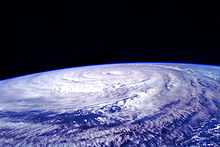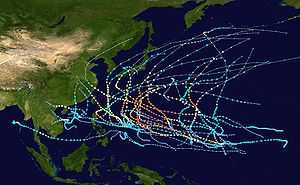Typhoon Winnie (1997)
| Typhoon (JMA scale) | |
|---|---|
| Category 5 (Saffir–Simpson scale) | |
 Typhoon Winnie near peak intensity on August 12 | |
| Formed | August 7, 1997 |
| Dissipated | August 25, 1997 |
| (Extratropical after August 20, 1997) | |
| Highest winds |
10-minute sustained: 185 km/h (115 mph) 1-minute sustained: 260 km/h (160 mph) |
| Lowest pressure | 915 mbar (hPa); 27.02 inHg |
| Fatalities | 372 total |
| Damage | $3.2 billion (1997 USD) |
| Areas affected | Northern Mariana Islands, Philippines, Taiwan, Japan and China |
| Part of the 1997 Pacific typhoon season | |
Typhoon Winnie, known in the Philippines as Typhoon Ibiang, was regarded as the worst tropical cyclone to impact the Chinese provinces of Zhenjiang, Fujian, Jiangsu and Shandong in 200 years. Originating from an area of low pressure over the Pacific Ocean on August 5, 1997, the system began as a depression . It headed northwestward, slowly strengthening to a tropical storm on the 9th. Intensification became more rapid as conditions became more favorable, and Winnie reached typhoon strength on the 10th. On 12 August 1997, it attained Super Typhoon status with peak winds of 160 mph. Winnie then weakened and passed north of Taiwan and made a landfall in Eastern China at minimal strength on 18th. It dissipated over land on 23rd binging heavy rain.
Meteorological history

On August 5, a tropical depression formed near the Marshall Islands. It headed northwestward, slowly strengthening to Tropical Depression 14W the next day by the JTWC. 14W strengthened into Tropical Storm Winnie on the August 9. Intensification became more rapid as conditions became more favorable, and Winnie reached typhoon strength on August 10. Two later, it became the 4th Super Typhoon of the season with peak winds of 160 mph. Soon after, the eye became ragged and large, with an outer eyewall reaching 200 miles in diameter. On August 18, the minimal Typhoon Winnie passed north of Taiwan and hit eastern China, where it winded down until dissipating on the 19th. The remnant continued northeastward, bringing heavy rain and damage across China until the 23rd.[1]
Impact

Philippines
In combination with the seasonal monsoon, rainfall from Typhoon Winnie killed at least 17 people in the northern Philippines on August 18. A total of 810,105 people were affected by the storm in the country, of which 53,654 were evacuated. A total of 204 homes were destroyed and 5,885 others were damaged. Preliminary damage was estimated at 60.188 million pesos ($2.2 million USD).[2]
Japan
Throughout the Ryukyu Islands and Kyūshū, Typhoon Winnie produced torrential rainfall, peaking at 450 mm (18 in) in Mikado, Miyazaki.[3]
Taiwan
Across Taiwan, Typhoon Winnie produced enormous amounts of rainfall, with some areas recording over 710 mm (28 in) over a 13 hour span.[4] At least 46 people were killed by the storm throughout the island,[5] 20 of whom were crushed by an apartment building which buckled and collapsed after the hillside it was on gave way near the town of Hsichi. Nine other people were trapped underneath the rubble and likely perished.[6] Near Taipei, six people were killed in a landslide, including two children. Three more drowned amidst flood waters near the city; another died after being blown off a roof while trying to break into a home; and a sixth died from unknown causes. Flooding in suburban Taipei left the entire first floor of buildings underwater, sending debris across streets turned into rivers. Large swells produced by the storm also eroded coastal highways along the eastern shores. Additionally, an estimated 68,000 people lost power in northern Taiwan.[4] Overall, damage from Winnie was estimated at $10 million across the island.[7]
People's Republic of China
In the People's Republic of China, Typhoon Winnie was regarded as one of the worst storms to strike the country in over a decade.[8] At least 310 people were confirmed to have been killed and damage exceeded $3.2 billion (1997 USD).[9] Additionally, over 3,000 people were injured by the typhoon.
Prior to the typhoon's arrival in mainland China, officials evacuated an estimated 1 million people from coastal areas. Along coastal Zhejiang, large swells produced by Winnie breached dikes at several towns, prompting the evacuation of 30,000 people. Across the province, heavy rains flooded at least 20,000 homes and killed at least 241 of people.[6][10] Thousands of homes were destroyed by the storm, which accounted for a majority of the fatalities.[11] In Shanghai, the Huangpu River broke its banks and inundated 400 homes with 1.5 m (4.9 ft) of water and knocked out power to thousands of residents.[6] An estimated 1.45 million people were isolated during the storm after thousands of towns were surrounded by flood waters. In Zhenjiang province alone, damage was estimated at 8.3 billion yuan ($1 billion USD).[12] Additionally, roughly 1.6 million acres of farmland was damaged, leaving $2.2 billion in losses.[11] In nearby Jiangsu and Anhui provinces, a more than 69 people were killed by the storm.[6][13]
Aftermath
Taiwan and the Philippines
In the wake of the typhoon, rescue crews were deployed throughout Taiwan, especially to the hard-hit areas around Taipei. At the site of the apartment collapse, rescue attempts were taken out for three days and after finding no additional survivors on the third, the remaining nine trapped within the rubble were presumed dead.[6]
In response to the widespread damage and flooding in the Philippines, the National Disaster Coordinating Council deployed disaster teams on August 20 to the affected regions to evacuate residents and begin relief efforts. The Philippine National Red Cross reported that it had enough food in store to serve 4,106 families in the wake of the storm.[2]
People's Republic of China
According to news reports in China, emergency crews were out and repairing dikes damaged or destroyed by the typhoon as early as August 20.[6] Within a few days of the storm's passage, food supplies and transportation had returned to normal in most of the affected areas.[14] Roughly 300 km (190 mi) of failed dikes in Zhenjiang were considered to be the main reason why the storm was unusually deadly and destructive. By August 23, residents began repairing their homes in parts of the province after having evacuated ahead of the storm.[15]
See also
References
- ↑ Joint Typhoon Warning Center. Super Typhoon Winnie (14W). Retrieved on 2007-01-07.
- ↑ 2.0 2.1 United Nations Department of Humanitarian Affairs (August 20, 1997). "The Philippines - Typhoon Winnie DHA-Geneva Situation Report No. 1". Center for International Disaster Information. Retrieved July 22, 2010.
- ↑ "降水量サマリービュー Typhoon 199713" (in Japanese). National Institute of Informatics. 1998. Retrieved July 22, 2010.
- ↑ 4.0 4.1 Associated Press (August 18, 1997). "Typhoon Winnie Kills 24 In Taiwan". The Columbian. Retrieved July 22, 2010.
- ↑ Reuters (August 21, 1997). "Typhoon Winnie kills at least 72". The Toronto Star. p. A.20. Retrieved July 22, 2010.
- ↑ 6.0 6.1 6.2 6.3 6.4 6.5 Associated Press (August 21, 1997). "Typhoon Winnie slams China as Taiwan cleans up". Sun Journal. p. 18. Retrieved July 22, 2010.
- ↑ Voice of America (August 21, 1997). "Work crews continue to clean up damage". ReliefWeb. Retrieved July 22, 2010.
- ↑ Associated Press (August 22, 1997). "Typhoon Winnie kills". Lodi News-Sentinel. p. 6. Retrieved July 22, 2010.
- ↑ Staff Writer (August 24, 1997). "World/Nation Briefs". Newsday. p. A.24.
- ↑ Jian-Min Li, Guochen Wan (August 21, 1997). "Typhoon Winnie Kills More than 241 in Zhejiang". China News Digest. Retrieved July 22, 2010.
- ↑ 11.0 11.1 Reuters (August 21, 1997). "Typhoon Winnie kills 140 in east China". CNN. Retrieved July 22, 2010.
- ↑ United Nations Department of Humanitarian Affairs (August 20, 1997). "China - Typhoon Winnie DHA-Geneva Situation Report No. 1". Center for International Disaster Information. Retrieved July 22, 2010.
- ↑ Staff Writer (August 20, 1997). "Typhoon Winnie Leaves Death and Devastation". Seattle Post-Intelligencer. Retrieved July 22, 2010.
- ↑ Associated Press (August 22, 1997). "Typhoon Winnie kills 56 in eastern China". Sun Journal. p. 20. Retrieved July 22, 2010.
- ↑ Xinhua news agency (August 23, 1997). "China: Typhoon caused 2.5bn dollars'damage in Zhejiang". BBC. Retrieved July 22, 2010.
External links
- JMA General Information of Typhoon Winnie (9713) from Digital Typhoon
- JMA Best Track Data (Graphics) of Typhoon Winnie (9713)
- JMA Best Track Data (Text)
- JTWC Best Track Data of Super Typhoon 14W (Winnie)
- 14W.WINNIE from the U.S. Naval Research Laboratory
| |||||||||||||
